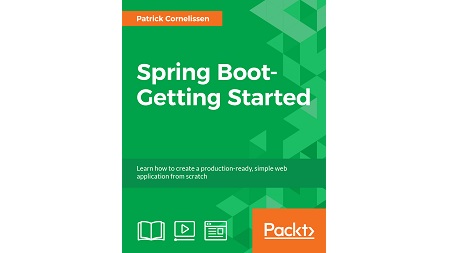
English | MP4 | AVC 1280×720 | AAC 44KHz 2ch | 6h 26m | 1.37 GB
Learn how to create a production-ready, simple web application from scratch
The Spring Framework is the leading alternative to Oracle’s Java EE offering. Spring Boot is the best option to start developing Spring applications with less code and a better development and operations experience.
This lesson is aimed at providing someone having a Java background with the necessary expertise to write a web-based application from scratch that stores data in a relational database and offers a REST-based API and a HTML interface.
We start by creating a new project and exploring the already provided test support. We then move on to add our first Web MVC controller and of course we add tests for this as well. With that knowledge we start to write our sample application and start with a REST-based API. Then, we add data storage via JPA and Spring’s JdbcTemplate.
Further on, we create an HTML interface with thymeleaf and add input validation to both APIs. Spring security is the next topic we explore to secure our application from malicious users. At the end we are going to learn how to configure our application, monitor it, and check out some advanced topics regarding Spring configuration classes and the Spring Expression Language (SpEL).
After completing this course, you will be able to write a maintainable application from scratch that can be deployed and operated with ease.
Key Features
- Create a Spring application from scratch
- Add a RESTful API and a rich web interface
- Store data in a relational DB with transactions
- Configure and operate a Spring Boot application
This course can be beneficial for novice Spring developers, web developers and Spring enthusiast. This will help them dive-in and understand core basics concepts of Spring Boot.
What You Will Learn
- Bootstrap and WebMVC first glance
- Creating an API and storing data into the database
- Creating a HTML based interface with thymeleaf
- Securing the app and preparing the application for the release
Table of Contents
01 The Course Overview
02 Creating a small project
03 The Spring context
04 Spring testing
05 Adding WebMVC dependencies
06 Adding interactivity
07 Adding interactivity – II
08 Spring MVC testing
09 Spring WebMVC testing – II
10 Adding a bookmark
11 Adding HATEOAS
12 Fetching a bookmark
13 Getting all bookmarks
14 Update a bookmark
15 Deleting a bookmark
16 Closing, ResponseStatus, and ResourceAssembler
17 Adding JPA dependencies
18 JPA entity and DAO
19 Adding Flyway for schema migration
20 Switching to JdbcTemplate
21 Switching to JdbcTemplate – II
22 Transactions
23 Adding Thymeleaf
24 Adding some more fields to the Bookmark class
25 Adding bookmark details page
26 Bookmark list
27 Deleting a bookmark
28 Adding a bookmark edit form
29 Adding validation dependencies
30 Enabling validation on the model
31 Activating validation in the REST API
32 Adding an add form
33 Adding validation to the HTML UI
34 Adding Spring Security dependencies
35 Adding the login form
36 Adding roles and authorization
37 Adding Spring Security to the HTML UI
38 Spring profiles
39 Configuration property classes
40 Spring Boot Actuator
41 Spring Boot Actuator – II
42 Advanced Spring configuration
43 Spring expression language
44 Spring expression language – II
45 Spring bean scopes
46 Spring bean scopes – II
47 Common configuration options
48 Common configuration options – II
Resolve the captcha to access the links!